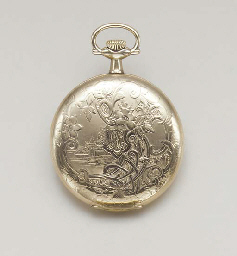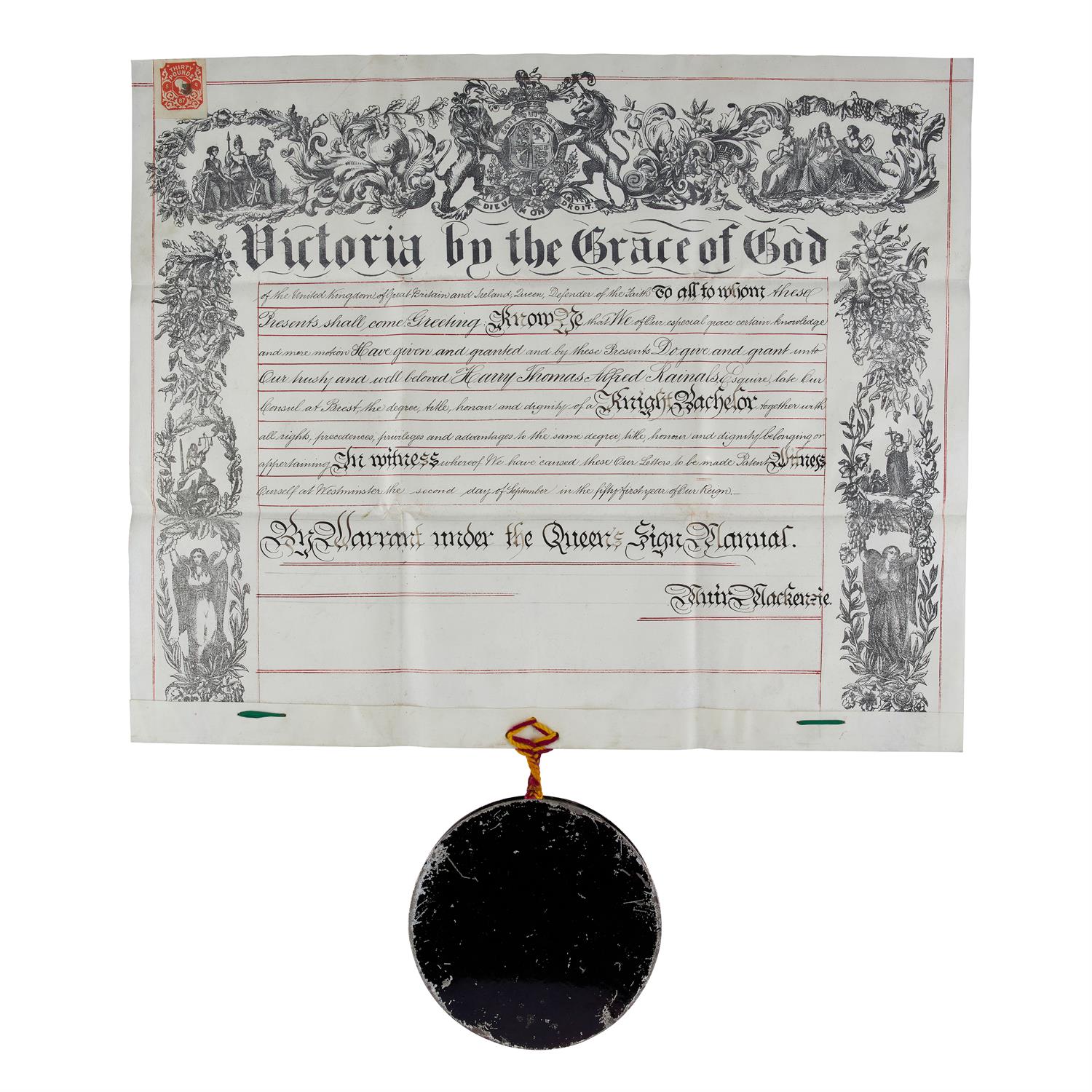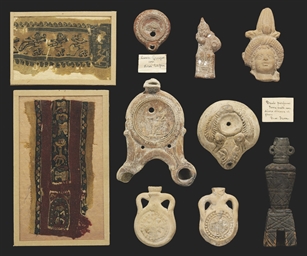Five large fragments of a previously unrecognised English Romanesque Giant Bible, in Latin, decorated manuscript on parchment [England, early twelfth century] Five strips from a single large bifolium (three cut horizontally from bifolium, two vertically), each approximately 395mm. by 60mm., with remains of double column, up to 41 lines in an elegant English Romanesque hand (with the capitula of I Maccabees, and the text of 1:3-62 and 4:18-5 and 23), one with part of running title “LIBER” at head and instructions for rubricator (“expliciunt capitula. Incipit ad maccabeorum”), small initials in alternate green and red, three large simple initials in green, red or blue (the red with baubles mounted in its body), numbered in pencil by N.R. Ker in July 1974, and with a letter recording his opinions of them, some scuffs, folds and areas of discolouration, but overall in good and solid condition, and on thick Romanesque parchment of excellent quality From the library of Ampleforth Abbey, their MS. 281: Ker, Medieval Manuscripts in British Libraries, 1977, II, p. 43. Their sale at Sotheby’s, 7 December 2010, lot 14. These stately cuttings are all that remain of a lost English Romanesque Giant Bible, one of the crucial stages in the development of the medieval Bible in which its format was stretched to the limits of the materials involved to produce a grand monolithic codex, often with opulent miniatures and decorations. The most complete of the two vertical strips contains 41 lines, and the words at the foot of the second column of the recto want so few characters (“…us et secundum diem in qua contaminaverunt illud gentes in i…”) before the opening of the text of the first column on the verso, that we can conclude that only one line is missing. We can use the surviving border at the top of the horizontal strip from the top of the bifolium to calculate an approximate original leaf height of at least 456 mm., and the same strip allows to calculate that the leaf width was 315 mm. (original written space: 326 by 95 mm. per column, with 16 mm. gap between the columns). This nearly rivals the grand benchmarks set by the Bury Bible (c.1130, 525 by 320 mm.; Cambridge, Corpus Christi College MS.211) and the Lambeth Bible (c. 1150, 520 by 325 mm.; Lambeth Palace, MS.3), and compares well with that of the magnificent Lothian Bible (c. 1220, 470 by 320mm.; New York, Pierpont Morgan Library M.791: Morgan, Early Gothic Manuscripts, I, 1982, pp.79-80), while dwarfing that of the Northumberland Bible (c. 1250-60, 325 by 210 mm.; sold Sotheby’s, 8 July 2014, lot 49). It is virtually inconceivable that even a substantial fragment of a codex of this type could now come to the market, and even fragments of leaves are of breathtaking rarity. It has been observed that among the 2200 pastedowns from Oxford bindings identified in N.R. Ker’s Fragments of Medieval Manuscripts Used as Pastedowns in Oxford Bindings (2004), not a single one comes from a English Romanesque Giant Bible, and only two are recorded in private hands (one a small fragment of 1 Kings and the John Hirsh New Testament fragment of the Bury Bible).
Five large fragments of a previously unrecognised English Romanesque Giant Bible, in Latin, decorated manuscript on parchment [England, early twelfth century] Five strips from a single large bifolium (three cut horizontally from bifolium, two vertically), each approximately 395mm. by 60mm., with remains of double column, up to 41 lines in an elegant English Romanesque hand (with the capitula of I Maccabees, and the text of 1:3-62 and 4:18-5 and 23), one with part of running title “LIBER” at head and instructions for rubricator (“expliciunt capitula. Incipit ad maccabeorum”), small initials in alternate green and red, three large simple initials in green, red or blue (the red with baubles mounted in its body), numbered in pencil by N.R. Ker in July 1974, and with a letter recording his opinions of them, some scuffs, folds and areas of discolouration, but overall in good and solid condition, and on thick Romanesque parchment of excellent quality From the library of Ampleforth Abbey, their MS. 281: Ker, Medieval Manuscripts in British Libraries, 1977, II, p. 43. Their sale at Sotheby’s, 7 December 2010, lot 14. These stately cuttings are all that remain of a lost English Romanesque Giant Bible, one of the crucial stages in the development of the medieval Bible in which its format was stretched to the limits of the materials involved to produce a grand monolithic codex, often with opulent miniatures and decorations. The most complete of the two vertical strips contains 41 lines, and the words at the foot of the second column of the recto want so few characters (“…us et secundum diem in qua contaminaverunt illud gentes in i…”) before the opening of the text of the first column on the verso, that we can conclude that only one line is missing. We can use the surviving border at the top of the horizontal strip from the top of the bifolium to calculate an approximate original leaf height of at least 456 mm., and the same strip allows to calculate that the leaf width was 315 mm. (original written space: 326 by 95 mm. per column, with 16 mm. gap between the columns). This nearly rivals the grand benchmarks set by the Bury Bible (c.1130, 525 by 320 mm.; Cambridge, Corpus Christi College MS.211) and the Lambeth Bible (c. 1150, 520 by 325 mm.; Lambeth Palace, MS.3), and compares well with that of the magnificent Lothian Bible (c. 1220, 470 by 320mm.; New York, Pierpont Morgan Library M.791: Morgan, Early Gothic Manuscripts, I, 1982, pp.79-80), while dwarfing that of the Northumberland Bible (c. 1250-60, 325 by 210 mm.; sold Sotheby’s, 8 July 2014, lot 49). It is virtually inconceivable that even a substantial fragment of a codex of this type could now come to the market, and even fragments of leaves are of breathtaking rarity. It has been observed that among the 2200 pastedowns from Oxford bindings identified in N.R. Ker’s Fragments of Medieval Manuscripts Used as Pastedowns in Oxford Bindings (2004), not a single one comes from a English Romanesque Giant Bible, and only two are recorded in private hands (one a small fragment of 1 Kings and the John Hirsh New Testament fragment of the Bury Bible).







.jpg)







Testen Sie LotSearch und seine Premium-Features 7 Tage - ohne Kosten!
Lassen Sie sich automatisch über neue Objekte in kommenden Auktionen benachrichtigen.
Suchauftrag anlegen